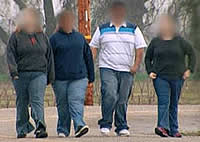 |
 |
Students at Lighthouse Community Charter School talk about food. See more of their videos.
Note: This article is the first of three in which WKCD highlights the stories of urban youth—and their adult allies—who are taking up the cause of healthy eating. The other two articles in the series are Rethinking School Lunch and Schoolyard Gardeners Nourish New Ideas. For an annotated list of all of the resources and links included in this series, click here.
by Barbara Cervone
 OAKLAND, CA—“My favorite food? I like sushi, California rolls,” declares Tyler Wallace, a seventh grader. “My least favorite food, I gotta say, is macaroni and cheese.” He is taking his turn to be quizzed by classmates with a Flip video camera, answering questions about what he eats.
OAKLAND, CA—“My favorite food? I like sushi, California rolls,” declares Tyler Wallace, a seventh grader. “My least favorite food, I gotta say, is macaroni and cheese.” He is taking his turn to be quizzed by classmates with a Flip video camera, answering questions about what he eats.
Families here at Lighthouse Community Charter School have long had trouble finding affordable and nutritious food in their low-income Oakland neighborhoods. That’s one reason the school makes healthy eating part of the curriculum.
But as Yamile, a seventh grader, points out, “Knowing the food pyramid is just the beginning.” So this team of Lighthouse middle-schoolers has set out to make teen nutrition their cause.
As part of a multi-city service-learning project with the National Council of La Raza, the kids have already helped to build and nurture a school garden. They are moving on to the next step of their campaign: shouting out the benefits of fruits and vegetables and the dangers of high-calorie processed foods.
“What did you eat in the last 24 hours?” Estefania demands, and Tyler rattles off the details:
“I ate some Jack in the Box, the double combo special, the one that’s $3.99. That was dinner. For breakfast I had some oatmeal with cinnamon. For lunch, I had pasta, vegetables, and yogurt, here at school. I like the food at school.”
Tyler only eats fast foods “to be quick about things,” he explains. “I mostly eat organic food— it’s better. My dad, he got diabetes and he didn’t want us to get that.”
Yamile’s favorite foods, she says, are spaghetti or carne asada. “Do you like organic food?” a classmate asks. “Yes, sometimes, but I mostly eat junk foods like Cheetos, pizza, chips. . . My favorite drink is orange soda.”
“Do you ever eat fruit?” asks Adam. “I love eating fruit,” Yamile answers. She favors watermelon and mango, especially with salsa.
Bella lists her food priorities: Mexican food, then spaghetti, Chinese—and tofu. “I don’t like the grease with fast food. It leaves that flavor in your throat and I hate that feeling. It’s nasty. I like home food better.”
Eating healthy food at home, however, does not always fit the hard-pressed schedules of urban families. As a result, what kids eat in and outside schools has become a matter of growing national concern.
To make their case for change in vivid local color, the team of middle-school investigators took digital cameras and went out to capture the world of fast, processed, and junk food, just across the street from their school.
The obesity connection
Stand in the hallway of just about any urban high school in the U.S. today, watch students pass and you’ll see a 21st-century health crisis: Almost a quarter of the students will be obese, another quarter overweight. Teens who are overweight at the age of 18 increase their risk of an early death by over a third, and those who are obese are twice as likely to die early. They face an increased risk of heart disease, diabetes, high blood pressure, and breathing problems.
 Studies have shown that a child who is obese between the ages of 10 and 13 has an 80 percent chance of becoming an obese adult. The U.S. Centers for Disease Control predict that if the current overweight and obesity trends continue, 86 percent of Americans—adults and children—could be overweight or obese by 2030. The current annual cost to society for obesity is estimated at nearly $100 billion.
Studies have shown that a child who is obese between the ages of 10 and 13 has an 80 percent chance of becoming an obese adult. The U.S. Centers for Disease Control predict that if the current overweight and obesity trends continue, 86 percent of Americans—adults and children—could be overweight or obese by 2030. The current annual cost to society for obesity is estimated at nearly $100 billion.
And like so many social issues, the links to income are stark.
In California, 21 percent of teenagers living in low-income families are obese, compared with only 8 percent in middle or high-income families. Children and families in poor neighborhoods are likely to have greater access to sources of high-calorie foods, such as fast-food outlets, and lower access to supermarkets or other stores that stock fresh produce and other healthy foods.
It will take a revolution
“When it comes to healthy eating, options are often very limited for urban youth,” says María Elena Torre, director of Education Studies at Eugene Lang College in New York City. In collaboration with What Kids Can Do (WKCD), Torre is engaging young people in two New York City neighborhoods to research and report on “food justice” issues in their communities—from food diversity and consumption to the impact of immigration and gentrification on local grocery stores. The youth researchers will document the challenges of eating healthy when you are young and poor, offering their own analysis and their own solutions.
“Given the chance to design their own food programs,” Torre adds, “youth come up with far more interesting and nutritious ideas. We need to let youth take the lead, inviting them to bring knowledge from their families and communities into their school cafeterias. For a true healthy food revolution to take root across America, all youth, including those in poor and working class areas, must be involved in unpacking the consequences of our becoming a ‘fast-food’ nation.”
The middle-schoolers at Lighthouse Community Charter School are signing up for that revolution, raising new questions just as they raise carrots and kale in their school garden.
Their video interviews, telling what they eat and showing where it comes from, may someday stand as a historical record—an artifact of youth making change, in the possible future where all kids eat well and grow strong.
RESOURCES AND LINKS
Healthy Eating, Active Communities
Healthy Eating, Active Communities is a six-year, multi-million program sponsored by The California Endowment. It aims to fight the growing childhood obesity epidemic in California and to develop state policy changes that will reduce the risk factors for diabetes and obesity. The website includes resources for collaborating and building partnerships, having the evidence and background data to make your case, policy advocacy, seeking grants to support this work, and more. (While the initiative is California based, many of the resources are valuable nationwide.)
KidsHealth from Nemours
KidsHealth is the number one most-visited website for children's health and development. Among its wealth of resources are special sections for teens on food and fitness and overall body health. Nemours is one of the nation’s largest health systems dedicated to the health of children.
KNACK Online
KNACK Online is a web site designed to help parents, community advocates, and youth workers address adolescent overweight and obesity through evidence-based, reliable, useful, down-to-earth and action-oriented resources. It was developed by the Kansas State University College of Human Ecology with the guidance of the health leaders of Kansas and is funded through the national Centers for Disease Control and Prevention.
ARTICLES AND RELATED READING
“Michelle Obama on Obese Kids and Healthy Eating,” Chicago Sun-Times, 10.21.09
“Teens Speak…About Getting Fit,” New York City Department of Health, 2007 (PDF)
“Proximity to Fast Food a Factor in Student Obesity,” New York Times, 3.25.09
“School Water Fountains to Prevent Obesity,” New York Times, 3.30.09
“New Factor in Teen Obesity: Parents,” Science Daily, 2.13.09
“Study Predicts Obesity Apocalypse by 2030,” ABC News, 8.2.08
“How the Food Makers Captured Our Brains,” New York Times, 6.22.09




